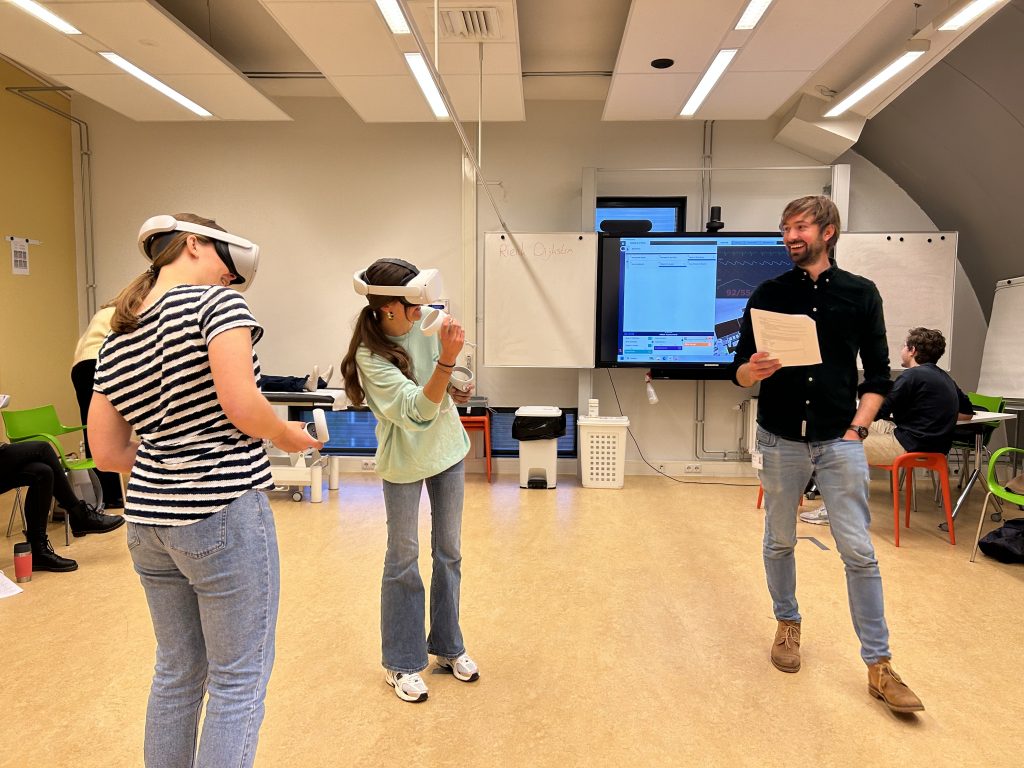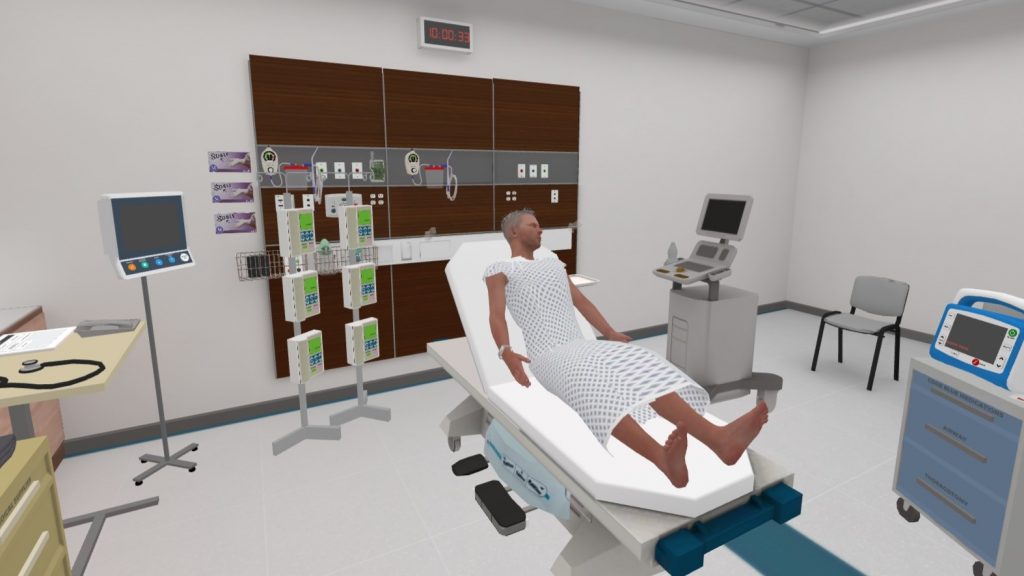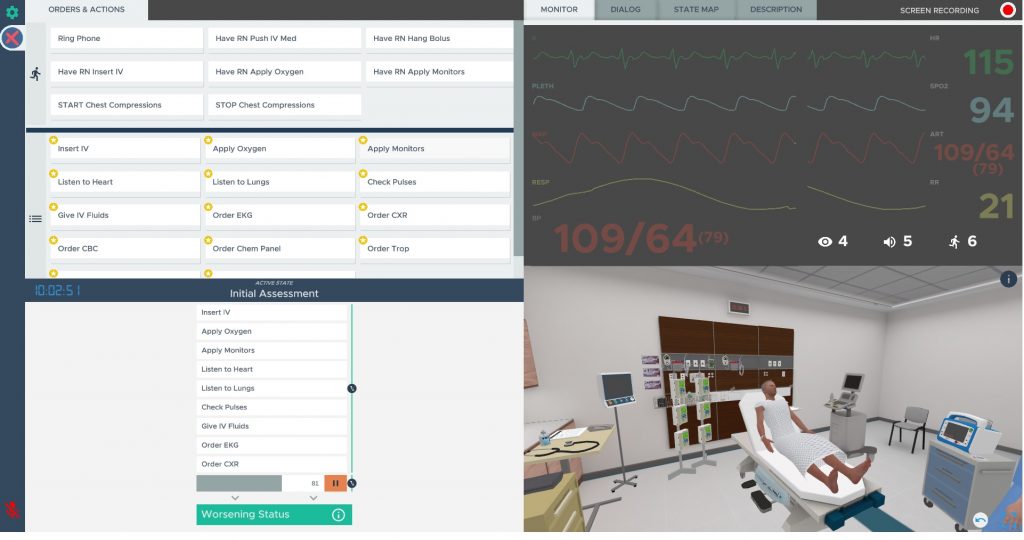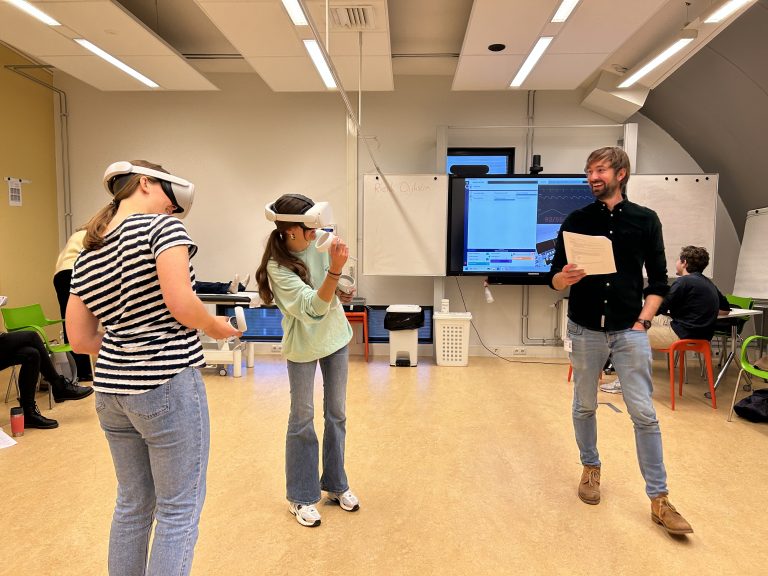Virtual reality is used to teach ABCDE skills to medical students: Rienk Dijkstra from the University Medical Center Groningen explains his approach.
Content written in collaboration with SimX
Rienk Dijkstra, an esteemed academic teacher at the University Medical Center Groningen, delves into the exciting realm of virtual reality (VR) technology and its use in healthcare simulation. As the project leader for a groundbreaking virtual reality innovation pilot project, Dijkstra is at the forefront of shaping the education of fourth-year medical students. We spoke with him to better understand his innovative approach.

Rienk Dijkstra
Rienk Dijkstra is an academic teacher at the University Medical Center Groningen / University Groningen. In this role he is also project leader for a virtual reality innovation pilot project for 4th year medical students. Rienk has conducted research on the application of the ABCDE-method in the ED, worked as a resident in the ED and specialized as a general practitioner.
1-SZ Hi Rienk, thank you very much for agreeing to have this chat with us and our readers. What got you to teach?
What got me to teach is that I am passionate about sharing my knowledge and experience with medical students. Besides that, teaching medical students requires staying up to date on current medical treatments and being open to changing outdated practices. This ensures that, as a teacher, I have to be a lifelong learner, which fits my curious personality. Medical educators can help shape the future of medicine by training the next generation of physicians, and I think it’s great to be part of this, despite having a small contribution. Last but not least, I love the interaction with students. Getting them enthusiastic about medicine and guiding them in their development to become a doctor gives me great fulfilment.

2-SZ Can you explain what VR Patient Encounter training is?
Virtual reality (VR) is a technology that uses computer programming to create a lifelike, 3D environment that replaces what our senses absorb, and it can be experienced through a VR headset. In the VR Patient Encounter application we use in our pilot project at the faculty, students are placed in a realistic scenario in which they have to apply the systematic ABCDE approach to a critically ill patient. In terms of set-up, it is very similar to the simulation training courses that are now given with manikins. In the VR patient encounter training it really seems like you are in the ER having a patient in front of you. You can interact with the patient and the environment and perform life saving actions. In this way, students gain clinical experience before ever seeing a critically ill patient in real life.
3-SZ In a study you published in 2017* you concluded that emergency department staff were capable of performing the ABCDE approach in the minority of potentially unstable patients and important factors determining this choice were the vital signs on triage and a quick first impression. Do you think VR Patient Encounter training can help improve this skill?
Our main goal of the pilot innovation project with the VR training was to develop a lesson based around existing software (the VR encounter training from SimX) for 4th year medical students and (temporarily) implement this in our curriculum. We wanted to find out from which lesson design students could potentially learn the most with VR. We didn’t research the effectiveness of VR, but from my point of view and the recent experience we gained with the VR lessons, I think it can certainly help improve ABCDE skills. Namely, VR education can give students a better understanding of the ABCDE approach as they will learn by doing, through performing the different steps themselves in a realistic scenario. This could possibly lead to a better understanding of what to do in real life scenarios in the future during internships or when they become a physician.

4-SZ Can you explain how you are using VR Patient Encounter training for ABCDE education to 4 year students?
Students prepare for the training by studying an e-learning in which they learn about the ABCDE systematics and what to expect from the virtual scenario. They can also familiarize themselves with what the emergency room looks like and where all materials (instruments and medication) are to be found. The training consists of an educator and six students, where the students form pairs and go through three different learning activities via a rotation schedule: VR scenario training applying the ABCDE methodology, observation and monitoring of the other duo’s VR scenario via an interactive whiteboard and independent small skills training on a BLS manikin. We use three different VR scenarios, so each student pair will have a different challenge, in which one will be a physician and the other will play as a nurse. When all three duos have completed the rotation schedule, they jointly debrief and reflect on the completeness of the ABCDE methodology, effectiveness of action during the scenario and communication and collaboration between them.
5-SZ What is the most exciting thing your students learn in your program?
What students find most instructive is they experience the VR scenario training as lifelike and actually feel compelled to act to save the patient. This gives them the emotions and adrenaline that cannot be achieved with simulation patients, as we usually do in the curriculum. And the great thing about this is that they experience enjoyment in their learning process and are allowed to make mistakes without the possibility of serious consequences.
6-SZ What were the challenges you had to overcome in implementing this program?
The most challenging part was ensuring the training could run smoothly technically and having a stable connection between the software and the VR headsets. In our faculty the network is highly secured, so exceptions had to be made for this project, which took a long time to implement. Fortunately, it is now working well. Another challenge was organizing the lesson, for example arranging time and manpower needed, training the educators for VR, setting up the teaching space in such a way that two students can move safely in the scenario, etc. Currently we are trying to implement VR in our curriculum, the challenge here is to find structural financial resources and to demonstrate the added value of VR. We will focus on both these aspects in the following phase of the project.

7-SZ What skills must the instructor have to make the best use of the VR Patient Encounter training?
In the first place, the teacher must be familiar with the ABCDE method and scenario training in general in order to be able to adequately guide the students. In addition, the teacher must also have sufficient technical knowledge to be able to use the VR headsets and software. In my opinion, someone with enough technical skills to install apps and adjust settings on a smartphone, will also be able to handle VR software and hardware. Furthermore, the teacher must know how the classroom is best set up, what materials and facilities are present in the scenario and what possibilities the scenario has for responding to the student’s actions. Finally, the trainer must take into account that VR can lead to physical complaints for some students (motion sickness) and how VR headsets can be adjusted, especially for students who wear glasses, to be able to see the scene clearly.
8-SZ What would you recommend to those who want to implement a similar training program?
The most important thing is to make an in-depth cost-benefit analysis and determine with which learning goal to use VR and to consider all alternatives. Consider applying VR only when VR offers a learning experience that cannot or cannot be sufficiently realized in any other way, but is necessary to achieve the learning goals. Also include the possibilities of structural financial implementation, because otherwise education will be developed that cannot be given structurally. A deception for both teachers and students. If you take this into account, you can realize incredibly fun and instructive lessons for students, which they attend with a lot of motivation and enthusiasm.
*Olgers, T. J., Dijkstra, R. S., Klerck, A. M. D., & ter Maaten, J. C. (2017). The ABCDE primary assessment in the emergency department in medically ill patients: An observational pilot study. The Netherlands Journal of Medicine, 75(3), 106-111
For more information, watch the video interview:
READ ALSO






























